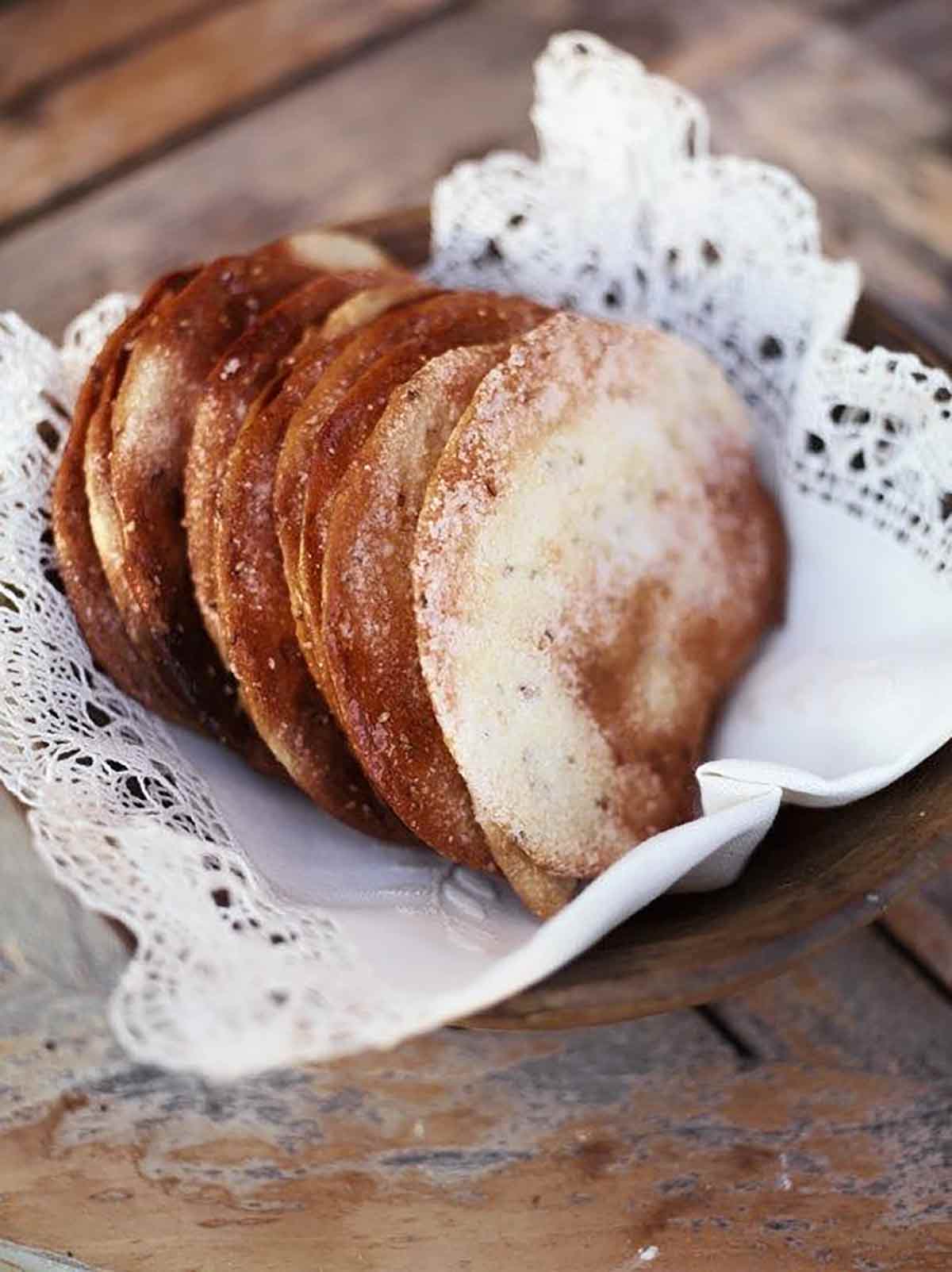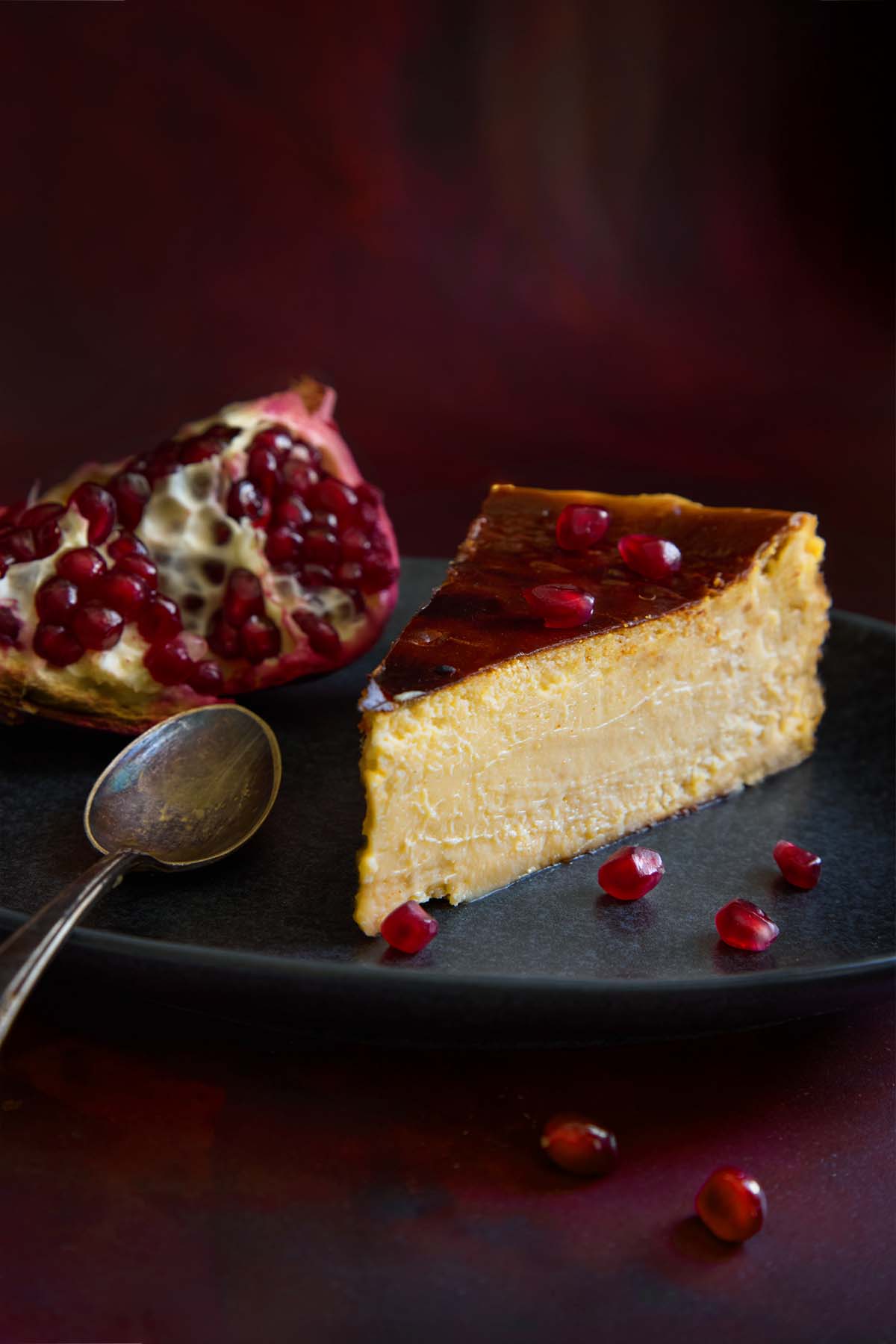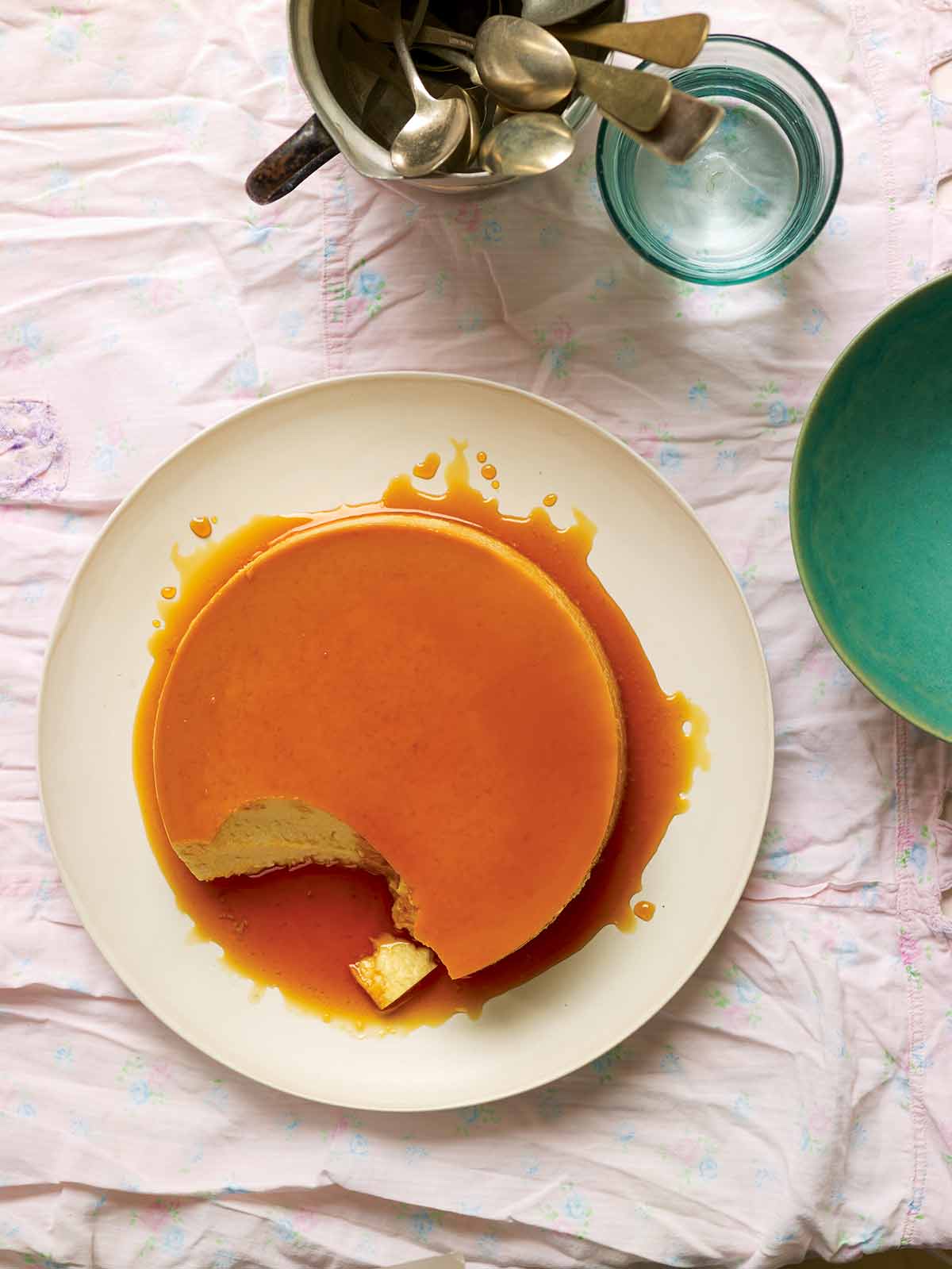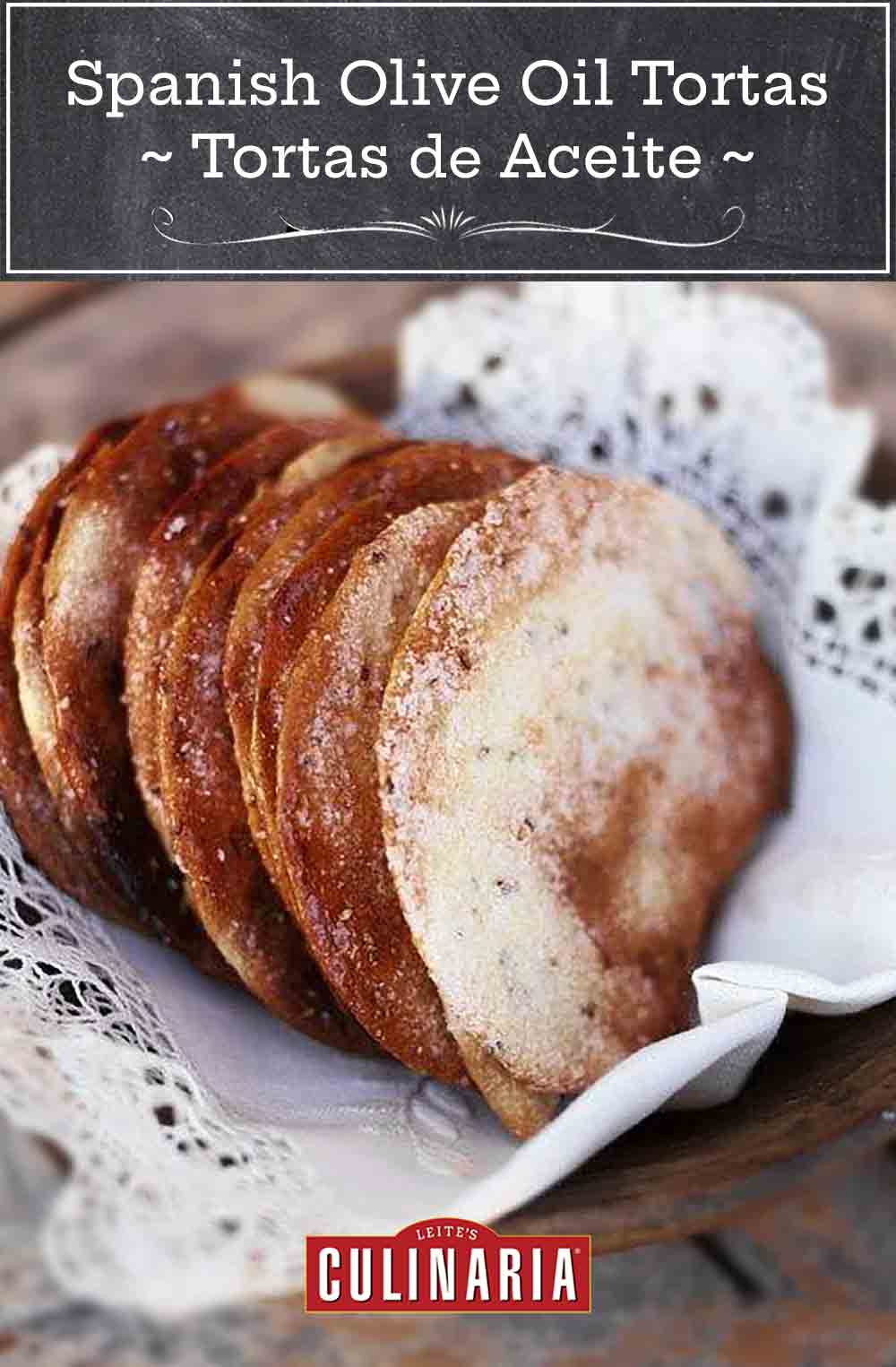
These Spanish olive oil tortas are known as tortas de aceite, or olive oil tortas, in their native Spain. (They’re even, we’re told, referred to as tortas del virgin by nuns. You can bet we’re researching the why behind this!) We’ve been wobbly in the knees for the packaged version, known as sweet olive oil tortas, since we first experienced them, and are partial to the brand Ines Rosales, which are shatteringly crisp, imbued with just the right amount of sweet, and ever so gently inflected with the occasional fennel seed. They’re oh so lovely with sparkling wine and go uncannily well with salty nibbly things such as olives and hard cheeses. They’re close to perfect. And now we can make them at home. And so can you.
*What is 00 Flour?
We (heart) 00 flour. The traditional flour used for pasta making in Italy, 00 flour isn’t inexpensive. But it is worth its weight in gold. Or tortas de aceite. Whichever you value more. Look for 00 flour at Italian delis and markets, specialty stores, and some grocery stores.
Want to Save This?
More Spanish Dessert Recipes



Spanish Olive Oil Tortas ~ Tortas de Aceite
Ingredients
- 1 1/2 to 2 1/2 cups Italian 00 flour* or cake flour
- 1 teaspoon sea salt
- 2 teaspoons fennel seeds
- Scant 1/2 cup Spanish extra-virgin olive oil, plus more for the baking sheets
- 2/3 cup warm water
- 3 tablespoons raw sugar, plus extra for sprinkling
- 2 teaspoons active dry or instant yeast
- Confectioners’ sugar, for dusting
- All-purpose flour, for the work surface
- 1 large egg white, beaten
Instructions
- Preheat the oven to 450°F (230°C).
- In a large bowl, stir together 1 1/2 cups flour (180 g), salt, and fennel seeds.
- Pour the oil into a measuring cup or another bowl containing the water, stir in the sugar and yeast, and mix well. Let rest for a few minutes until it becomes frothy.
- Make a well in the center of the flour mixture and slowly pour in the yeast mixture, using a fork to gradually mix in the flour. When everything starts to come together, use your hands to mix it into a smooth dough. If the dough is sticky as heck, add some or all of the remaining 1 cup flour, a little at a time, until a smooth dough forms. It's quite possible you'll need to add at least 1/2 cup and as much as the full 1 cup.
- Lightly oil 2 large baking sheets and then dust them with confectioners’ sugar. Lightly flour a clean work surface and a rolling pin with all-purpose flour.
- Divide your dough into 12 equal-size pieces and shape each one into a ball. Roll out each ball until it’s almost translucent and somewhere around 4 inches in diameter.
☞ TESTER TIP: It's not a specific thickness, such as 1/16 or 1/8 inch, that you want to look for with the dough. Rather, it's when the dough becomes so thin as to be almost transparent. That's when you know it's at the proper place. And don't worry about attaining a perfect circular shape. These are intended to be rustic.
- Place each torta on a baking sheet and lightly brush with some beaten egg white. Lightly dust the dough first with confectioners’ sugar and then a little raw sugar.
- Bake for 5 to 12 minutes, or until golden and crisp. Watch the tortas closely as they can burn in seconds.
- Immediately transfer the tortas to wire racks to cool and crisp. Devour warm or at room temperature. The tortas will crumble into flaky loveliness as you take a bite, and will then quickly dissolve into sweet nothingness within seconds. So lovely.

Explore More with AI
Nutrition
Nutrition information is automatically calculated, so should only be used as an approximation.
Recipe Testers’ Reviews
I made these Spanish olive oil tortas thinking I wouldn’t like them. I was wrong. The recipe was no-fuss—it was easy to put together, all the ingredients were in the pantry, and the cooking time was quick. The result was a slightly raised, fennel-y tasting biscuit that’s a perfect pairing for morning coffee or afternoon tea.
I made 10 biscuits instead of 12. I used rubber rings (1/8 inch thick) on the rolling pin so that I could control the thickness. The diameter of each biscuit was approximately 4 inches. Perfect!
I recently purchased a package of Spanish olive oil tortas for the first time and was hooked. They’re one of those wonderfully addictive food things that’s not too sweet, has a fabulous crispness, yet is somehow delicate. I immediately started looking for a recipe to make them at home, but none was that clear. Then, voilà! One magically appeared.
Unfortunately, I’m not much of a baker, so the errors I made were all mine. But the flavor of these tortas de aceite was actually more interesting than the ones I had given the addition of the fennel. Perfect!
I did use nearly a full cup more flour than the initial 1 1/2 cups flour the recipe called for, as I had a batter, not a dough. The dough was incredibly easy to roll out into circles, although mine weren’t thin enough. My most successful ones had thinner edges that crisped up beautifully. They need to be rolled out to nearly translucent.
I made them a second time and rolled the dough very, very thin. They were much better—delicious in fact, but I took the oven temperature down to 400°F and the bake time to 6 to 7 minutes. They were easier to roll by hand, as the fennel seeds caused holes in the dough when it was run through a pasta maker. I still can’t get them quite as crispy and flaky as I remember the store-bought tortas de aceite being, but they’re absolutely fabulous. I measured the extra flour needed to make a rollable dough, and it was an additional 1/2 cup.
My yield was 24 cookies, each 4 inches in diameter. I’m now determined to get these babies perfect since I want to give them as Christmas gifts with a bottle of that gorgeous limoncello. Great recipe!
These exquisite Spanish olive oil tortas are extremely easy to make, and they taste almost exactly like the commercial—and expensive—tortas de aceite you can find in many grocery stores. The instructions are clear, and the ingredients are easy to find if they’re not already on hand. (Tip: I passed over the cake flour several times because it was in a box, not a bag. This proves that you only see what you expect to see. Duh.)
The dough is soft, fragrant, and slightly greenish from the oil. I did find that I needed to add almost 1/2 cup additional flour in order to roll out the dough. I rolled my dough into a cylinder and cut it into 12 portions. Each dough ball weighed about 2 ounces. I rolled my dough to about 6 inches in diameter, which was thin enough to see through. It’s a little tricky to roll a nice circle, but I’m sure that’s just a matter of practice, and besides, these are rustic crackers. Brushing the top of the torta with egg white and sprinkling it with sugar adds a lovely caramelized crust.
My first batch was slightly burnt at 8 minutes baking time. I found 6 1/2 minutes to be about right, but I would start checking at 5 or 6 minutes. I took my tortas off the baking sheet almost immediately to avoid burning. They crisp up nicely as they cool. I made them a second time with a few changes. I used instant yeast (as that’s all I had on hand), which worked great. The tortas seem to be a little flakier than the batch with active dry yeast. I baked this batch at 425°F instead of 450°F, and they came out perfectly in 6 1/2 minutes.
So beautiful and so delicious! I love these spread with goat cheese for breakfast
I was sure I wouldn’t like making these Spanish olive oil tortas. I’m not a happy cookie baker or happy to do anything fiddly. And these were fiddly. But they were worth it.
The dough was way too wet to work into a “lovely smooth dough” with just 1 1/2 cups flour. I used Italian Tio 00. Even with almost 1/2 cup more added, it was a very soft, sticky dough. I gave up on the rolling pin and used my floured fingers to shape the 4 inch circles, which worked fine. .
These were tasty. My Portuguese daughter-in-law liked them and so did I!











Hello! Glad to have found this recipe. They are my favourite storebought snack. Two questions…
1.) how could I make these the orange flavour
2.) any vegan replacement for the egg white?
Thanks!
Harriet, you can add orange zest to the dough for a lovely citrus flavor. I’ve not made this with anything other than eggs, so I can’t confidently suggest a vegan replacement without testing. But if you find one, please let me know!
Great recipe. Make sure you roll them as thin as possible for maximum crunch. Taste great.
Nina, I’m delighted you enjoyed the olive oil tortas. And thanks for the tip; Im sure it will help other bakers.